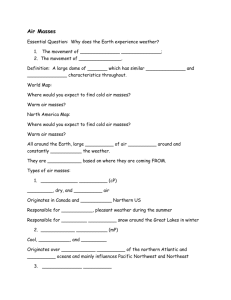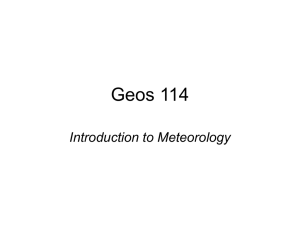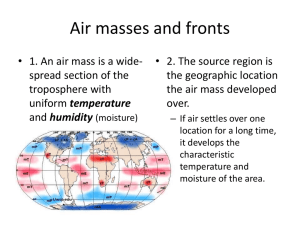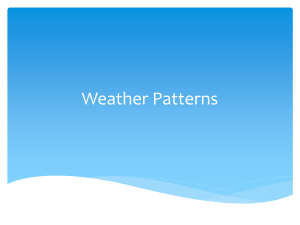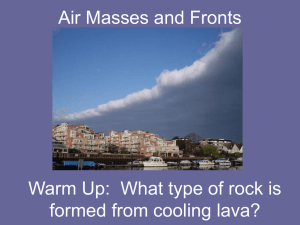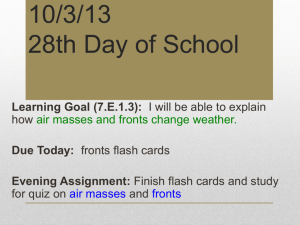Understanding Fronts
advertisement
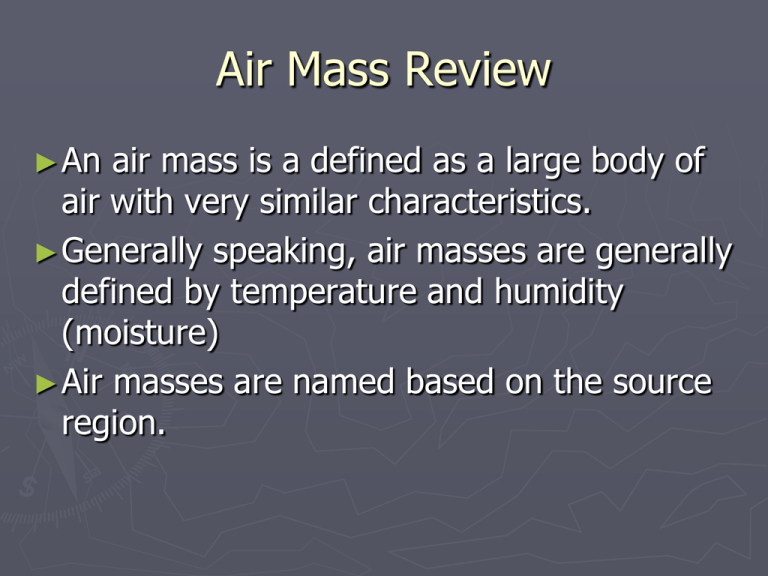
Air Mass Review ► An air mass is a defined as a large body of air with very similar characteristics. ► Generally speaking, air masses are generally defined by temperature and humidity (moisture) ► Air masses are named based on the source region. Types of Air Masses ► Continental Polar (cP), “cold and dry” Originates closer to the Poles over land-locked regions. Not as cold as Arctic air masses. Forms farther to the south than Arctic air, more common. Central and northern Canada and Alaska. ► Continental Tropical (cT), “hot and dry” Originates closer to the Tropics over land-locked regions. Usually forms over the Desert Southwest and northern Mexico. ► Maritime Polar (mP), “cool and moist” Originates closer to the Poles over water. Usually brings cloudy, damp weather, not as cold as continental air. ► Maritime Tropical (mT), “warm and humid” Originates over warm tropical waters of the Southern Atlantic and the Gulf of Mexico. Responsible for hot, humid days of summer across the South and East. “Blue Ice Weather” Hypothesis: In your spiral notebook on the next available LEFT HAND SIDE PAGE, predict what you think will happen when you add the blue ice cube and red food coloring to water in the plastic container? Procedure: 1. Fill the plastic box two-thirds full with water at room temperature. 2. Wait until the water is completely still before doing step 3 3. Carefully drop a blue ice cube into the water at one end 4. Carefully drop three or four drops of red food coloring at the other end 5. Watch what happens! Results: Describe what happened in your science spiral underneath your hypothesis. Conclusion: Write a conclusion in your spiral notebook underneath the results. Why do you think this happened? How do you think this is related to air masses and/or weather? Understanding Air Masses & Fronts Sometimes two air masses with different temperatures and humidity bump into each other…. When this happens a FRONT is formed! Front – boundary where unlike air masses meet, but do not mix. There are 4 types: cold, warm, stationary and occluded. The kind of front that develops depends on the characteristics of the air masses and how they are moving. Types of Fronts ► Cold A fast-moving cold air mass overtakes a warm air mass ► Warm A warm air mass overtakes a slow-moving cold air mass. ► Stationary Cold and warm air masses meet, but neither can move the other. ► Occluded A warm air mass is caught between two cooler air masses. Cold Front http://www.phschool.com/atschool/phsciex p/active_art/weather_fronts/ Cold Front ► Marked on a map with a blue line and blue triangles pointing towards the warm air. ► Associated with cumulus & cumulonimbus clouds ahead of the front in the warm air, producing showers and thunderstorms. Warm Front http://www.phschool.com/atschool/phsciex p/active_art/weather_fronts/ Warm Front ► Marked on a map by a red line with red semi-circles pointed towards the cool air (in the direction the warm air is retreating to.) ► Generally associated with stratus type clouds, overcast skies, fog, and general rain or snow. Stationary Front ► Marked by alternating blue lines & blue triangles (pointed in the direction of the warmer air) and red lines & red semi-circles (pointed in the direction of the cooler air) ► Water vapor in the air condenses into rain, snow, fog or clouds. If it remains over an area it may bring days of clouds and precipitation. http://www.phschool.com/atschool/phsciex p/active_art/weather_fronts/ Occluded Front ► Marked by a purple line with alternating purple triangles and purple semi-circles, all pointing in the direction of the frontal movement. ► The weather may turn cloudy and rain or snow may fall http://www.phschool.com/atschool/phsciex p/active_art/weather_fronts/ http://www.phschool.com/atschool/ph sciexp/active_art/weather_fronts/

